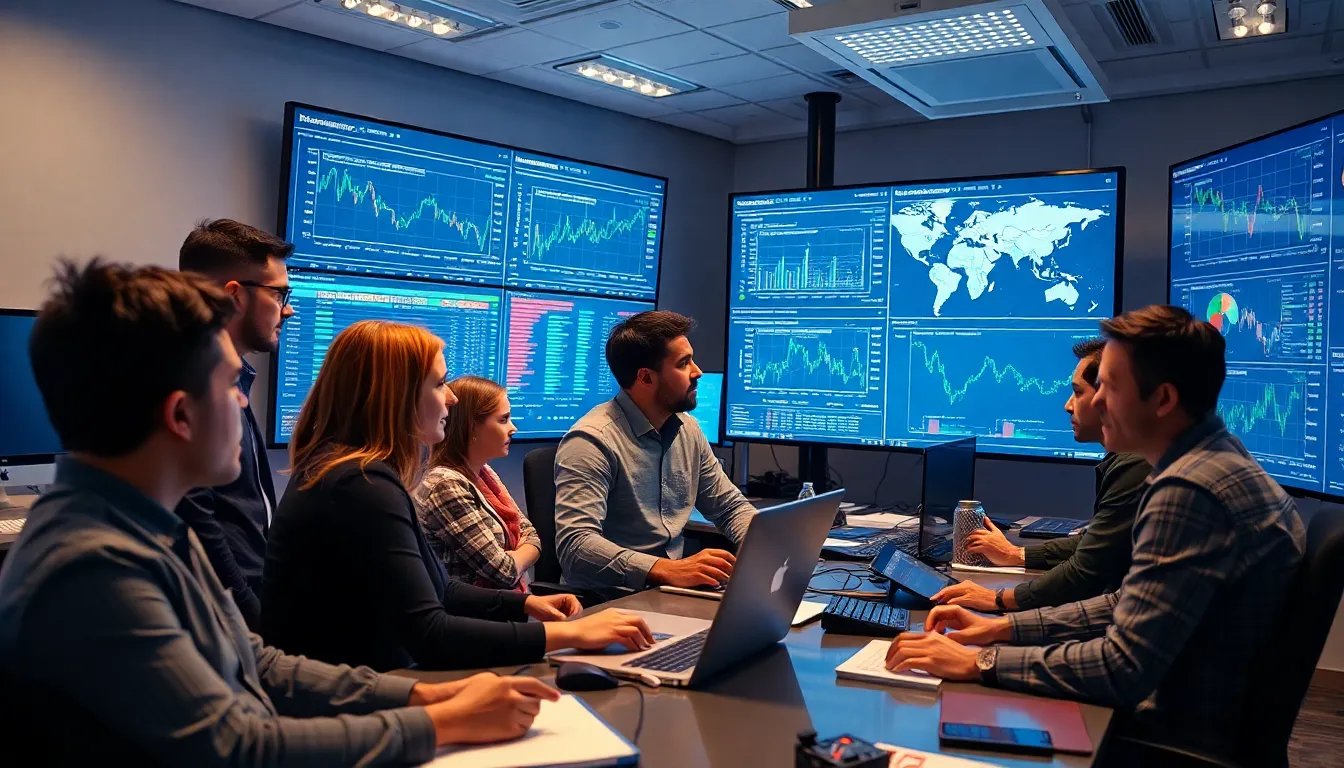Table of Contents
ToggleIn a world where digital transactions are becoming the norm, understanding blockchain forensics is crucial. This emerging field combines technology and investigative techniques to track and analyze blockchain activities, uncovering hidden patterns and illicit transactions. As cryptocurrencies gain popularity, so do the challenges of fraud and cybercrime, making blockchain forensics an essential tool for law enforcement and financial institutions.
Blockchain forensics not only helps in tracing the flow of digital assets but also plays a vital role in ensuring compliance with regulations. By leveraging advanced analytical methods, experts can identify suspicious activities and provide insights that aid in preventing financial crimes. As the landscape of digital finance evolves, the importance of blockchain forensics will only continue to grow, making it a key area of focus for businesses and regulators alike.
Overview of Blockchain Forensics
Blockchain forensics involves the application of investigative techniques to analyze and track activities on a blockchain. This field plays a crucial role in ensuring compliance and mitigating financial crimes within the growing landscape of digital transactions.
Definition and Importance
Blockchain forensics refers to the process of examining blockchain data to identify, track, and analyze the flow of digital assets. This discipline is vital for law enforcement agencies and financial institutions, as it aids in detecting fraud, money laundering, and other illicit activities. By tracing transactions, forensic analysts can uncover the origins of funds and identify participants in criminal activities. Blockchain forensics is essential for building trust and transparency in an increasingly centralized and decentralized financial system.
Key Concepts in Blockchain Technology
- Decentralization: Blockchain operates on a distributed network, eliminating the need for intermediaries and enhancing transparency.
- Immutability: Transactions recorded on a blockchain cannot be altered, ensuring data integrity and providing a reliable audit trail.
- Anonymity: Users can conduct transactions with varying levels of anonymity, complicating the identification of participants involved in illicit activities.
- Smart Contracts: These self-executing contracts automate and enforce agreements without intermediaries, but they also present unique challenges for forensic analysis.
- Blockchain Explorers: Tools that allow users to view transactions and verify blocks, aiding forensic investigators in monitoring blockchain activity.
Understanding these concepts enhances the effectiveness of blockchain forensics, enabling analysts to navigate the complexities of digital finance while identifying and preventing fraudulent activities.
Tools and Techniques in Blockchain Forensics

Blockchain forensics utilizes various tools and techniques to analyze blockchain data effectively. These resources help investigators identify illicit activities, trace transactions, and enhance transparency in digital finance.
Data Analysis Tools
Data analysis tools play a crucial role in blockchain forensics. They enable analysts to scrutinize large volumes of blockchain data efficiently.
- Chainalysis: Chainalysis offers robust data analytics software that tracks cryptocurrency flows across networks. It helps law enforcement and financial institutions detect illicit activities and comply with regulations.
- Elliptic: Elliptic provides comprehensive transaction monitoring tools. Their platform uses machine learning to identify suspicious transactions and assess the risk associated with specific wallets.
- CipherTrace: CipherTrace specializes in cryptocurrency intelligence. Their tools assist in tracking the movement of digital assets and provide insights into potential threats such as money laundering.
Blockchain Explorers
Blockchain explorers serve as essential tools for navigating blockchain data. They allow users to view transaction details, address balances, and block information.
- Etherscan: Etherscan focuses on the Ethereum blockchain. It enables users to track transactions, check token balances, and view smart contract interactions.
- Blockchain.com Explorer: This explorer provides access to Bitcoin’s blockchain. Users can explore transactions, analyze wallet addresses, and view network statistics.
- BlockCypher: BlockCypher supports various blockchains, enabling detailed data exploration across multiple networks. Its features include transaction tracking and API access for developers.
These tools and techniques enhance the effectiveness of blockchain forensics, empowering investigators to combat fraud and ensure compliance in the evolving digital finance landscape.
Applications of Blockchain Forensics
Blockchain forensics plays a crucial role in both crime investigation and regulatory compliance, providing essential insights into the flow of digital assets. This section delves into the primary applications of blockchain forensics across various sectors.
Crime Investigation
Blockchain forensics assists law enforcement agencies in tracing the origins and movements of digital assets linked to criminal activities. Investigators utilize advanced tools to identify illicit transactions, connect them to known criminal entities, and gather evidence for prosecution. Techniques such as clustering, which groups similar wallet addresses, allow investigators to detect suspicious patterns and connections among criminals. Notable cases include the investigation of ransomware attacks and the recovery of stolen cryptocurrencies, showcasing how blockchain forensics aids in solving cybercrimes effectively.
Regulatory Compliance
Financial institutions and regulators rely on blockchain forensics to comply with AML (Anti-Money Laundering) and KYC (Know Your Customer) regulations. Forensics tools enable entities to monitor transaction activities and assess risks associated with different wallets and exchanges. By analyzing transaction patterns, institutions can implement measures to prevent money laundering and ensure adherence to regulatory standards. Regular audits of blockchain data bolster transparency and trust, fostering a safer financial environment for consumers and businesses.
Challenges in Blockchain Forensics
Blockchain forensics faces several challenges that complicate the investigation of digital transactions. Understanding these challenges is essential for effectively addressing illicit activities within blockchain networks.
Anonymity and Privacy Concerns
Anonymity inherent in many blockchain protocols presents a significant challenge. Users can conduct transactions without revealing their identities, making it difficult to connect digital assets to real-world individuals. Privacy-focused cryptocurrencies, such as Monero and Zcash, use advanced cryptography to obfuscate transaction details, further complicating tracking efforts. Law enforcement agencies often struggle to trace these transactions, hindering investigations. Additionally, regulations surrounding user privacy can limit the access forensic analysts have to necessary data, impeding their ability to analyze transaction flows effectively.
Evolving Technologies
Rapid advancements in blockchain technology continuously introduce challenges for forensic investigations. New protocols and innovations can alter transaction patterns and improve the methods used to obscure identities. Decentralized finance (DeFi) platforms and non-fungible tokens (NFTs) add complexity to transaction analysis, as these assets often lack traditional transaction structures. Moreover, the rise of mixing services, which blend multiple transactions to conceal the source of funds, further obscures analysis. Forensic tools must adapt quickly to these technological shifts, necessitating ongoing research and investment in advanced methodologies to keep pace with evolving threats.
Future of Blockchain Forensics
The future of blockchain forensics hinges on technological advancements and evolving challenges in the digital finance landscape. Continued development in tools and methodologies will streamline investigations and enhance tracking efficiency.
Trends and Innovations
Emerging trends in blockchain forensics focus on integrating artificial intelligence (AI) and machine learning (ML) for real-time data analysis. AI-driven platforms can identify unusual transaction patterns, improving the speed and accuracy of investigations. Innovations in multi-chain analysis tools enable forensic experts to track assets across various blockchain networks, enhancing cross-chain compatibility. Furthermore, partnerships between blockchain forensics companies and law enforcement agencies tighten collaboration, facilitating prompt responses to cybercrimes.
Potential Impact on Law Enforcement
Blockchain forensics transforms law enforcement capabilities by refining investigative techniques and enhancing case resolution times. Investigative agencies leverage forensic tools to uncover intricate networks of illicit activities, significantly improving asset recovery rates in cases like fraud and money laundering. Integration of blockchain forensic methodologies into existing workflows allows law enforcement to adapt to the rapid evolution of criminal tactics, ensuring they remain effective in combating financial crimes. The ability to trace funds across multiple jurisdictions also bolsters international cooperation in investigations, addressing the global nature of digital crime.
Blockchain forensics is becoming increasingly vital in the fight against cybercrime and financial fraud. As digital transactions continue to rise the need for effective tracking and analysis of blockchain data is more crucial than ever. The tools and techniques available empower investigators to uncover illicit activities and bolster compliance with regulations.
With the rapid evolution of blockchain technology ongoing research and innovation in forensic methodologies will be essential. The integration of AI and machine learning promises to enhance the capabilities of forensic experts enabling them to adapt to emerging challenges. As this field advances it will play a pivotal role in ensuring a secure and transparent financial environment for all.







